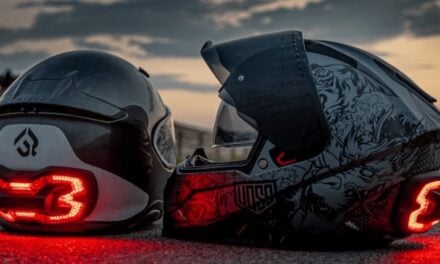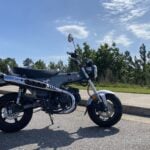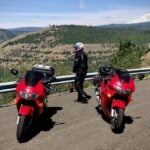We Ride The Honda Rebel 1100 DCT- The Future Of Motorcycling?
Honda’s venerable Rebel has been a staple in the brand’s cruiser line for decades. First introduced in 1985 as a small displacement/entry level 250cc twin, the bike was bumped up to a 450cc in 1986 and immediately lived up to its name by raising the ire of Harley-Davidson for its American cruiser looks and distinctive growl, which the Motor Company unsuccessfully sued them over. The Rebels, both the 250 and short-lived 450, were targeted at younger riders from the outset, in hopes of attracting a new generation to motorcycling. The bike has remained in the Honda CM and CMX line of cruisers off and on over the years before undergoing a complete makeover in 2017, which produced the upgraded 300cc and 500cc bikes that have sold so well to newbies and old farts alike.
Interestingly, It has been the success of the smaller Rebels that led Honda to develop the 1100cc version. Honda discovered that 88 percent of new 300 and 500 owners hopped on a larger bike within 18 months, yet 73 percent of those weren’t buying a Honda. That was a problem. So the braintrust set out to build a new Rebel, a bigger Rebel, a badder Rebel, that was also just as easy to learn on and ride as its elder “little siblings”. Viola, the Rebel 1100, in manual and DCT tranny.
The 2021 Honda Rebel 1100 DCT- they’ve nailed the look.
We were offered the chance to sample one of the DCT machines for about a month, to fully acclimate to it and basically ride the wheels off it. We of course jumped at the chance. Colin of Honda USA met with us when we took delivery of the Rebel, giving us the straight skinny on how the auto DCT (Dual Clutch Transmission) works. I’ve only ridden a few automatic motorcycles over the years, none of them recent decade models, so I paid close attention to his instructions before motoring off with the bike. I’m glad I did, as his prep made everything so clear for me.
Okay, I know what some are thinking- “No clutch means no fun,” or “automatics are for sissys,” or “that’s not a real motorcycle if you’re not shifting with a clutch.” Blah, blah, blah. Those same critics likely drive a car or truck with an automatic tranny, and they haven’t stick-shifted a “cage” in years, maybe decades. So let’s be open to new things, people. And may I remind us all, automatic motorcycles have been developed and sold by many moto brands over the years, and the tech keeps getting better with each new iteration. This Honda DCT system was derived from Honda’s Formula 1 racing and high performance automobiles, and is also offered on the new Africa Twin and on the Goldwing since 2018. And it’s sweet.
Loving me some Fall in the South.
As Colin described it, the dual-clutch tranny operates by actually actuating two gears at the same time. One clutch operates 1st, 3rd, and 5th, while the second operates 2nd, 4th and 6th. When in 1st gear, the gearbox is actually in 1st-2nd at the same time, with 1st engaged and 2nd free spinning. Shift into 2nd, and the bike engages 2nd while 3rd freespins. 3rd is 3rd-4th, and so on up to 6th. It operates this way whether in automatic or manual with paddle shifting. I’ve seen the diagrams and read the descriptions, and that’s the best way I can describe it. All I know is that it works, and seamlessly. That DCT is butter smooth.
To be honest, not having a clutch lever took some getting used to. I regularly found myself reaching for a lever that wasn’t there, and throttle roll-on is instantaneous, since I wasn’t doing the delicate dance of releasing the clutch lever while rolling on the throttle, for launch and each gear shift. I found myself jumping forward a time or few until I retrained my brain to match roll-on tension to desired acceleration. I’m telling ya, there’s not likely a cruiser on the street that could take a Rebel 1100 DCT in a light-to-light race, as there’s no need to let off the gas between shifts, whether in manual or auto shifting. Might even give a sport biker a bit of concern. Not divulging how I arrived at that assertion…
No clutch lever? No problem.
A couple of the Road Dirt guys asked what my first impressions of the Honda Rebel 1100 DCT were after the first week or so, and what came to mind was “customizable.” Sporting the same powerplant as in the 1100 Africa Twin only retuned for a cruiser vibe, this Rebel uses four ride modes, Rain, Standard, Sport and User, each with their own adjustable settings. The rider can adjust settings for P (Power, essentially throttle response), T (Traction), EB (Engine Braking, really liked this), and D (Drive when in auto). Via the Mode button on the left handlebar grip, you can Select up or down to raise or lower the setting in each one, or in User mode, set each to your own liking, which will work whether you’re in automatic or manual paddle shifting. Of course, the rider can actually override and paddle shift up/down even in Rain, Standard or Sport, the system is so versatile. Phil felt like it was a lot of options, yet I actually enjoyed fettling with the different settings, testing the characteristics of each, and ultimately found a “sweet spot” in User that I rode in the majority of the time I had the bike in my shed. I really like this Rebel’s customizable offerings.
I’m 5’8”, so I found the slammed 27.5” seat height quite welcome, and coupled with a fairly neutral rider triangle, though the handlebar pulled me forward slightly, the Rebel 1100 DCT was a comfortable all-day bike. Except for the tank capacity. Holding 3.6 gallons and getting about 37 mpg with that DCT auto tranny, the Rebel 1100 has a range of about 130 miles (that we found) before you’re on fumes. Not very long legs. The Rebel tips the scales at a tick over 500 lbs. fully fueled and lubed, which is still pretty svelte for a cruiser. It’s got a nice rake/trail of 28 degrees by 4.3”, with a wheelbase of just under 60”. This bike drew comments of “cool” everywhere we parked it. Nice lean angle, ABS, wheelie control, traction control, all switchable, means diving the Rebel into curves and powering out is easier (and more fun) than on most cruisers. The more I rode it, the more I liked it.
A highly customizable ride, and the settings I enjoyed the most.
It’s the little things that can really set apart a motorcycle from the competition, and in the case of the Honda Rebel 1100 DCT, I found some details I liked, and some I didn’t. The electrical wire bundle from the dash display to the back of the headlight could’ve been hidden with a fly screen or something. Coolant hoses on either side of the engine have a braided but frayed wrap that looks cheap, and a couple of electrical connectors or sensors could’ve had a rubber cover placed over them. Yet I liked the boot guards Honda thought of for both footpegs, keeping the rider from melting their boot sides/soles on the lower engine parts, as well as the matched matte black covers over casings on both sides, serving as heat shields too. The DCT is in neutral when off, necessitating a left handlebar parking brake. Lift to click engages the brake, then lift slightly and depress the button below the parking brake to disengage. I didn’t have many occasions to necessitate the parking brake, but found it handy in a couple of steep parking angle situations. I also appreciated how easily accessible the oil, tranny fluid, and engine coolant were on the lower left side. Basement mechanics like myself can easily service this bike on their own.
We enjoyed a beautiful, mild Autumn here in the Deep South, with abundant sunshine, low humidity, and cool daytime temps averaging in the 60s-70s all through September, October and November. Only rained I think a total of 8 days or so in three months, and we capitalized by riding the Rebel nearly every day, whether day trips or errand runs. I found the automatic “Drive” mode extremely handy in dense traffic situations, where a manual clutch would leave my left hand tired by constantly riding the friction zone with the lever. On the Rebel 1100 DCT, traffic negotiation was effortless with no clutch to feather. The DCT tranny freewheels while stopped, and engages once you roll on the throttle. 1st to 2nd shifts with a slight clunk, but every other gear shift is seamless and barely discernible, whether in Drive or paddle shifting.
The Old South in Autumn- rolling in and around historic Madison, Georgia.
As with so many bikes these days, Honda outfitted the big Rebel with a cruise control via the right grip, and I applied it while on a long stretch of state highway out to Madison, Georgia. Very fine-tuned, and maintains the set speed flawlessly. The ABS is front/rear integrated, with a single disc, dual pot brake up front and a single disc, single pot brake in back. Interestingly, the front and rear brakes are linked when using the hand brake, but the rear brake only is actuated when using foot brake. The Rebel rolls on a #525 O-ring sealed chain with 16 by 42 teeth sprockets, and exhales via a 2 into 1 exhaust on right side, with a surprisingly robust exhaust note. I honestly don’t think I’d change it, were I to buy one for myself. It looks and sounds good stock.
Phil and I are like night and day from each other, he being a tall, long-reach tourer rider, and me being a short, sport/standard rider. Which means our perspectives on bike reviews can appeal to a wide range of riders. So here’s Phil’s thoughts on his time with the Rebel 1100 DCT-
Phil’s Impressions
I’m 6’2” vertically, so unless it’s from the Motor Company in Milwaukee, I rarely fit on many of the newer bikes being offered. The Honda Rebel 1100 DCT is a bit small for me but I must admit, the bike was still a road-load of fun. I really like the way Honda has approached the DCT set up as Colin described, from the customizable controls on down. They made it very easy for a novice with no clutch experience to get underway on this bike. It does take an engineer to understand their toggle and pod screen settings, at least in my opinion. I’m going to assume a dealer rep will walk a new owner through all the options and settings and how to work them via the Menu control switch setup on the left side of the bars.
I rode the bike mostly in Standard mode which was fine – I’m hoping the Sport mode handles the transmission and shifting better. I live in a very hilly area and had to flick the paddle shifter to downshift every time I started to climb a hill. That may be due to my size but was a disappointment, yet then again, this bike is targeted at a newer generation of rider and the softer sex will probably not have a problem with it either.
Did we mention that 4-beam headlight? We love it.
The bike handles nicely, even for us big boys. Unlike Rob, I’m a bit pensive diving into turns quickly – I guess this comes from my time on big baggers – but the Rebel almost insisted I roll on the throttle and lean harder than I’m used to. A few times I felt uneasy as the bike is so damn light I felt like it might tip over but a quick blip and it planted it’s shoes in turns and got me upright and ready for the next. I typically rely on a bit of engine braking in twisties so I was pleasantly surprised by the power in turns even with an automatic transmission – very little downshifting was needed to get back on the throttle.
Overall I think Honda has done an excellent job on the Rebel 1100 DCT. It has a nice blacked out finish, a smooth quick engine and is a great value. I look forward to seeing how far they can tune and deliver the DCT transmission. This bike provides a legitimate clutch & shiftless fossil fueled option to new riders coming into the culture. Now where did they park that Goldwing?
We enjoyed Honda’s latest DCT offering- every minute and mile.
Final Thoughts
We were quite impressed with this fantastic, ground-breaking motorcycle Honda is offering. The DCT tranny is revolutionary for motorcycling, and this very well could be a linchpin machine that invites and attracts a new generation into our sport/lifestyle. If it sells well, if it fills a niche and meets a need, I’d fully expect to see more auto offerings from Honda, and the other brands scrambling to catch up. The Rebel 1100 DCT was introduced in a difficult time, this pandemic period we’re living in, but with the world trying to open back up and find some new sense of normal, maybe this is really the perfect time for this bike. An idea whose time has finally come? We personally hope so.
For more on the Honda Rebel 1100 DCT, click here:
Rob
*View our full ride review below, without ever leaving this page-








































I bought a 1100 DCT in March, I now have over 25000 miles on it. I am 77 years old and My Harley Heritage Classic was just to heavy for me. The is fun to ride.
Great to hear, Richard, and glad you’re still riding. Best to ya,
I’m 69 years old and have had my Rebel 1100DCT on order for 3 months.
At 6 feet tall weighing in at 190 pounds.
Having never sat on one, does anyone think I will need bar risers or move the foot controls more forward?
At 15 yrs old in 1967 I learned to ride on Harley 74 with a kick starter.
My only motorcycle experience has been with Harleys and Yamahas, large heavy touring motorcycles in excess of 700 pounds.
With arthritis in both hands and lost in strength, I hope the Rebel 1100 DCT is the right motorcycle for me.
The riding modes, low seat height, cruise control as well as other safety features is the reason I chose this motorcycle.
Hi Jerry,
We think you’ll be happy with it. Phil our “media guru” spent some time astride the bike while in our possession, and at 6’2”, he felt the rider triangle was doable for him. Between now and when your bike comes in, if you can find one at a dealership near you, it would be worth it to make the trip to straddle one, take a test ride, and get an initial feel for it.
Best to you!
the brakes are not linked using handbrake